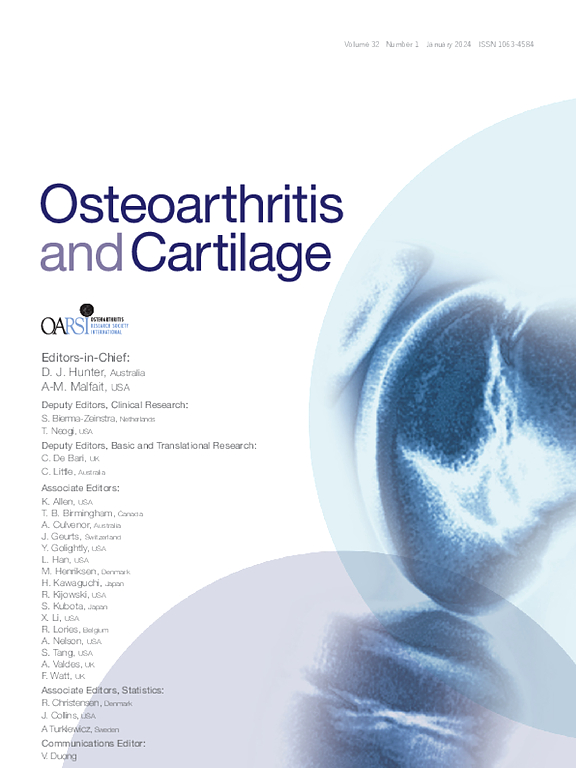Correlation between Gut Dysbiosis, Metabolite Alterations and Erosive Hand Osteoarthritis - an observational study within the community-based Xiangya Osteoarthritis (XO) cohort.
IF 7.2
2区 医学
Q1 ORTHOPEDICS
引用次数: 0
Abstract
OBJECTIVES Erosive hand osteoarthritis (EHOA) is an aggressive subtype of hand osteoarthritis (HOA) with unclear pathogenesis. Since gut dysbiosis and related metabolite alterations may exacerbate inflammation and accelerate bone destruction, we investigated whether these abnormalities were involved in EHOA. METHODS Participants were drawn from the Xiangya Osteoarthritis Study. We compared gut microbial α-diversity and β-diversity between EHOA and controls (neither EHOA nor non-erosive HOA), and analyzed associations between microbial species abundance, functions, and EHOA. Targeted blood metabolomics were performed to identify microbiome-associated metabolites in EHOA. The associations between EHOA-related microbial species and blood metabolites were examine through multi-omics analyses. RESULTS Among 1,324 participants, significant differences in α-diversity (EHOA: median=4.53, non-HOA control: median=4.16; median difference=0.37 [95%CI: 0.09-0.57], P=0.016) and β-diversity (R²=0.002 [95%CI: 0.0018-0.006], P=0.015) were observed at the species level between EHOA and controls. Participants with EHOA had a higher relative abundance of Alistipes senegalensis (β coefficient:0.17 [95%CI:0.07-0.26]) and Fournierella massiliensis (β coefficient:0.39 [95%CI:0.28-0.49]). Tryptophan metabolism was the main altered metabolic pathway. Targeted blood metabolomics showed higher levels of L-5-hydroxytryptophan (β coefficient:0.38 [95%CI:0.15-0.61]), 3-indoleglyoxylic acid (β coefficient:0.35 [95%CI:0.01-0.69]), 5-hydroxyindoleacetic acid (β coefficient:0.27 [95%CI:0.09-0.45]), indoleacrylic acid (IA) (β coefficient:0.23 [95%CI:0.001-0.46]), and serotonin (β coefficient: 0.20 [95%CI: 0.004-0.40]), alongside lower levels of L-tryptophan (β coefficient:-0.41 [95%CI:-0.75 to -0.06]) and indole-3-acetyl-aspartate (β coefficient:-1.05 [95%CI:-1.79 to -0.32]) in EHOA. IA was positively correlated with EHOA-related microbial species, particularly Alistipes senegalensis (β coefficient:0.20 [95%CI:0.14-0.27]). CONCLUSIONS A higher relative abundance of Alistipes senegalensis and alterations in tryptophan metabolites, particularly higher levels of IA, are associated with EHOA.肠道生态失调、代谢物改变与糜烂性手骨关节炎的相关性——一项基于社区湘雅骨关节炎(XO)队列的观察性研究
目的:糜烂性手骨关节炎(EHOA)是一种侵袭性手骨关节炎(HOA)亚型,其发病机制尚不清楚。由于肠道生态失调和相关代谢物的改变可能加剧炎症并加速骨破坏,我们研究了这些异常是否与EHOA有关。方法从湘雅骨关节炎研究中抽取受试者。我们比较了EHOA和对照组(既不是EHOA也不是非侵蚀性HOA)肠道微生物α-多样性和β-多样性,并分析了微生物物种丰度、功能和EHOA之间的关系。采用靶向血液代谢组学方法鉴定EHOA中微生物组相关代谢物。通过多组学分析,研究了ehoa相关微生物物种与血液代谢物之间的关系。结果在1324名受试者中,α-多样性(EHOA:中位数=4.53,非hoa对照组:中位数=4.16;EHOA与对照组在种水平上的中位差异=0.37 [95%CI: 0.09-0.57], P=0.016), β-多样性(R²=0.002 [95%CI: 0.0018-0.006], P=0.015)。EHOA患者的塞内加尔阿利斯氏菌(β系数:0.17 [95%CI:0.07-0.26])和马塞利福涅尔氏菌(β系数:0.39 [95%CI:0.28-0.49])的相对丰度较高。色氨酸代谢是主要的代谢途径。靶向血液代谢组学显示,l -5-羟色氨酸(β系数:0.38 [95%CI:0.15-0.61])、3-吲哚乙酸(β系数:0.35 [95%CI:0.01-0.69])、5-羟基吲哚乙酸(β系数:0.27 [95%CI:0.09-0.45])、吲哚丙烯酸(IA) (β系数:0.23 [95%CI:0.001-0.46])和5-羟色胺(β系数:0.20 [95%CI: 0.20])水平较高。0.004-0.40]),同时EHOA中l-色氨酸(β系数:-0.41 [95%CI:-0.75至-0.06])和吲哚-3-乙酰-天冬氨酸(β系数:-1.05 [95%CI:-1.79至-0.32])水平较低。IA与ehoa相关的微生物种类呈显著正相关(β系数为0.20 [95%CI:0.14 ~ 0.27])。结论塞内加尔Alistipes较高的相对丰度和色氨酸代谢物的改变,特别是较高的IA水平与EHOA有关。
本文章由计算机程序翻译,如有差异,请以英文原文为准。
求助全文
约1分钟内获得全文
求助全文
来源期刊

Osteoarthritis and Cartilage
医学-风湿病学
CiteScore
11.70
自引率
7.10%
发文量
802
审稿时长
52 days
期刊介绍:
Osteoarthritis and Cartilage is the official journal of the Osteoarthritis Research Society International.
It is an international, multidisciplinary journal that disseminates information for the many kinds of specialists and practitioners concerned with osteoarthritis.
 求助内容:
求助内容: 应助结果提醒方式:
应助结果提醒方式:


